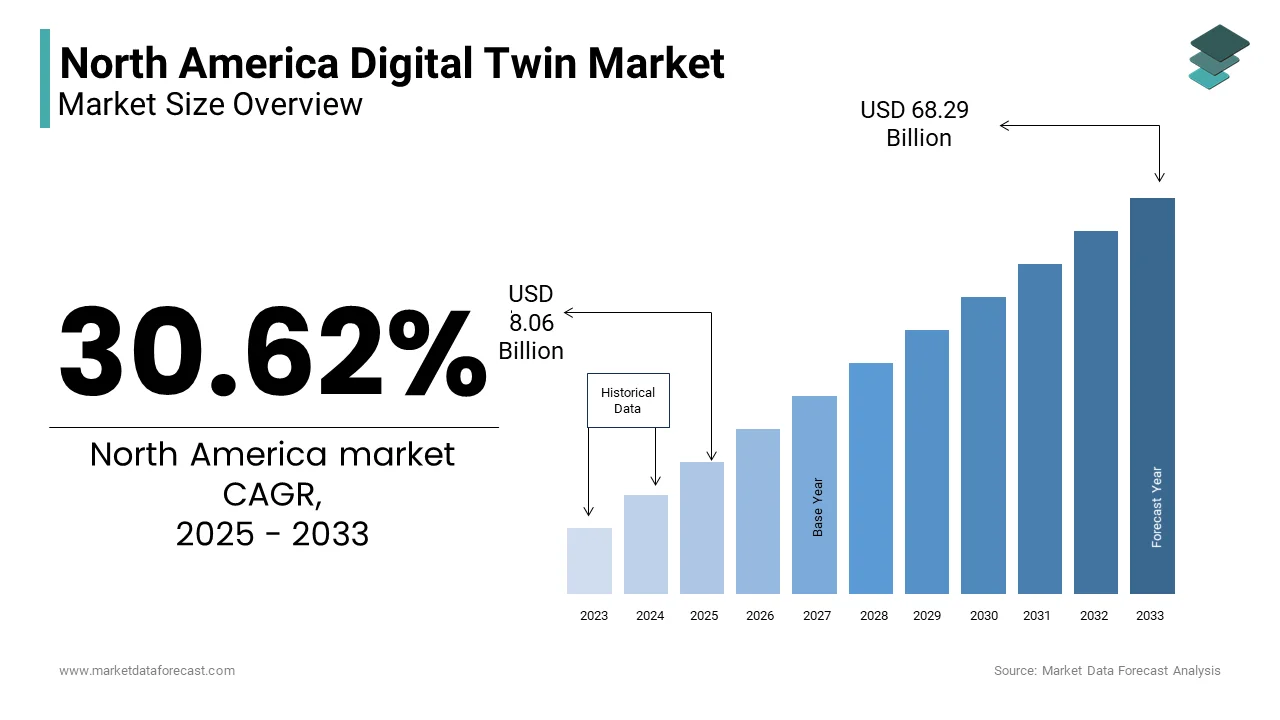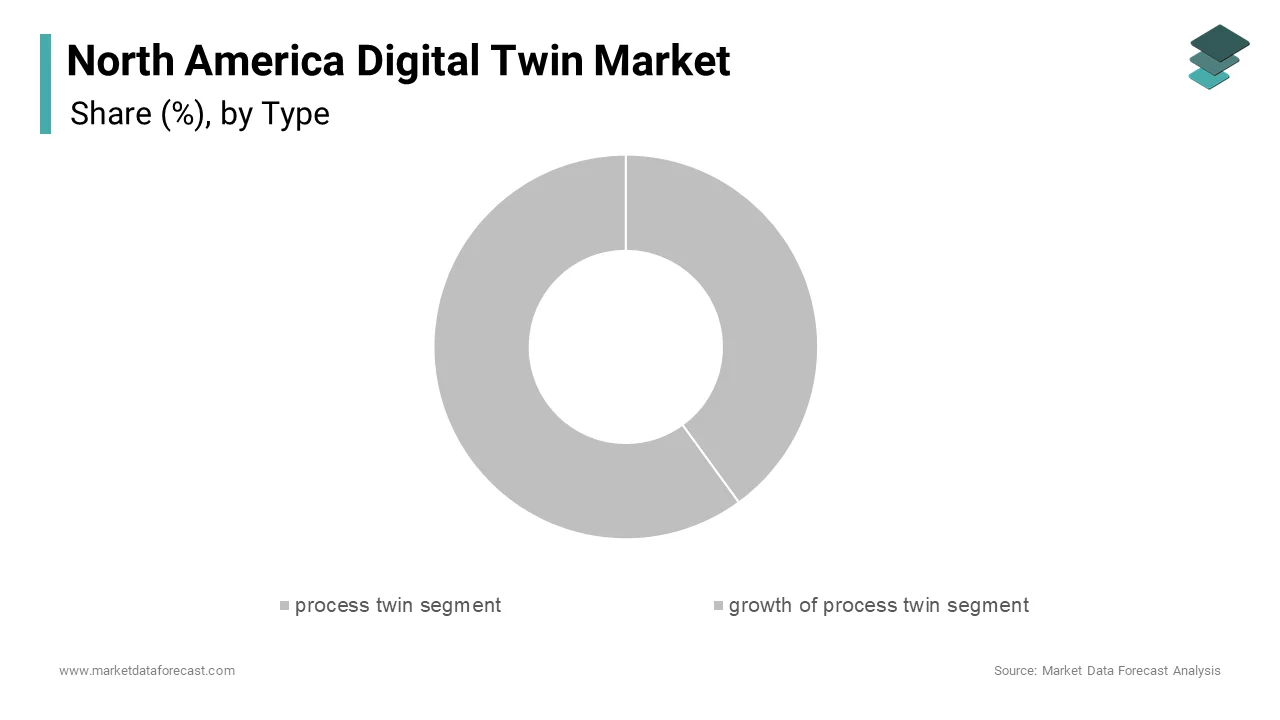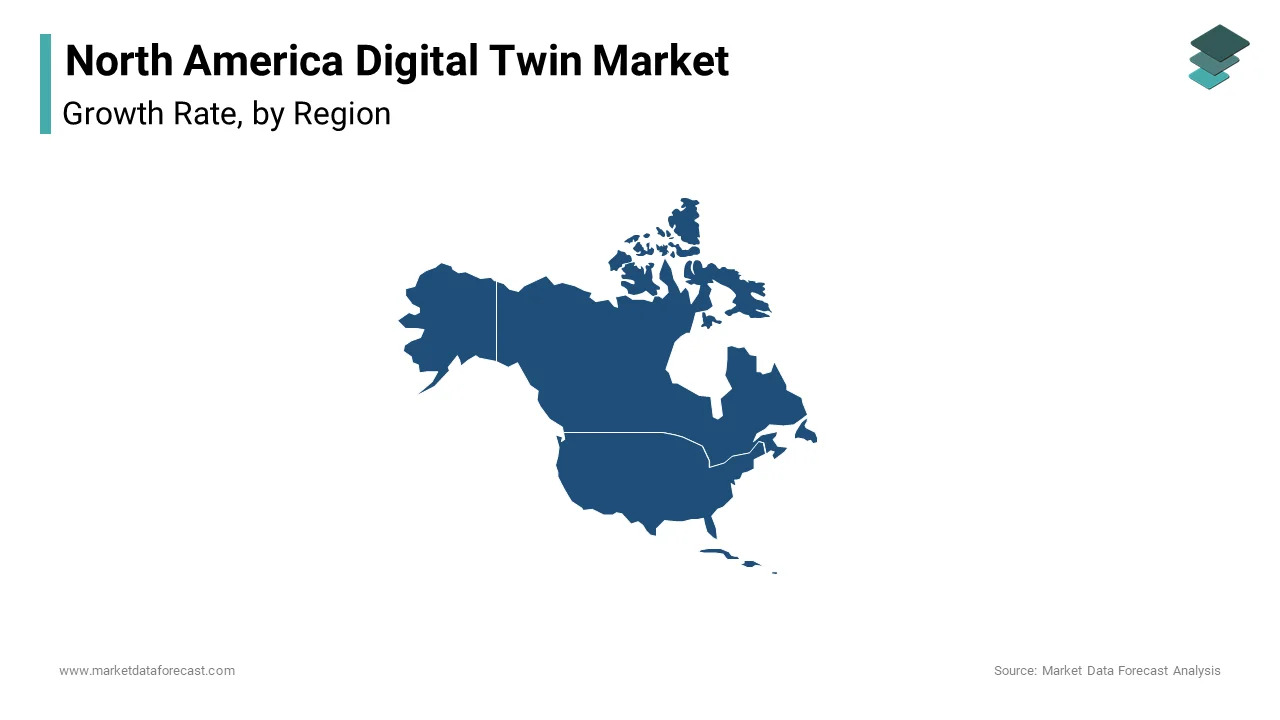North America Digital Twin Market Research Report – Segmented Type (process twin segment ,growth of process twin segment ) Application (predictive maintenance segment, business optimization segment)End-User (manufacturing segment, healthcare segment) & Country (US, Canada, Rest Of NA) - Industry Analysis On Size, Share, Trends,& Growth Forecast (2024 To 2033).
North America Digital Twin Market Size
The size of the North America digital twin market was worth USD 6.17 billion in 2024. The North America market is anticipated to grow at a CAGR of 30.62% from 2024 to 2033 and be worth USD 68.29 billion by 2033 from USD 8.06 billion in 2025.

A digital twin integrates real-time data from sensors and IoT devices to simulate, predict, and optimize performance by enabling organizations to enhance decision-making and operational efficiency. This innovative technology is increasingly being adopted across various sectors by including manufacturing, healthcare, automotive, and aerospace, as companies seek to improve their competitive edge through data-driven insights. This growth is driven by several factors, including the increasing adoption of IoT technologies, the need for predictive maintenance, and the demand for enhanced operational efficiency. The digital twin market is expected to witness significant advancements and innovations as organizations recognize the value of real-time data and analytics in optimizing performance.
MARKET DRIVERS
Increasing Adoption of IoT Technologies
The North American digital twin market is significantly driven by the increasing adoption of Internet of Things (IoT) technologies across various industries. The demand for digital twin solutions has surged. The digital twins leverage data collected from IoT sensors to create accurate virtual representations of physical assets by enabling organizations to monitor performance, predict failures, and optimize operations. This capability is particularly valuable in sectors such as manufacturing, where real-time insights can lead to improved efficiency and reduced downtime. The integration of IoT with digital twin technology allows for enhanced predictive maintenance, enabling companies to address issues before they escalate into costly failures. The North American digital twin market is expected to experience sustained growth by the rising demand for innovative solutions that enhance operational efficiency and decision-making.
Demand for Predictive Maintenance
Another major driver of the North American digital twin market is the growing demand for predictive maintenance solutions. The need for advanced maintenance strategies has become paramount as organizations increasingly recognize the importance of minimizing downtime and optimizing asset performance. According to a study by Deloitte, predictive maintenance can reduce maintenance costs by 25% to 30% and increase equipment uptime by 10% to 20% by making it an attractive option for businesses seeking to enhance operational efficiency.
Digital twins play a crucial role in predictive maintenance by providing real-time insights into asset health and performance. The digital twins can identify patterns and anomalies that indicate potential failures by allowing organizations to take proactive measures. This capability not only reduces the risk of unexpected breakdowns but also extends the lifespan of assets by leading to significant cost savings. The demand for digital twin solutions that support predictive maintenance is expected to grow is driving the expansion of the North American digital twin market.
MARKET RESTRAINTS
High Implementation Costs
One of the primary restraints affecting the North American digital twin market is the high implementation costs associated with developing and deploying digital twin solutions. While the benefits of digital twins are well-documented, the initial investment required for technology, infrastructure, and skilled personnel can be a significant barrier for many organizations. This financial burden can deter small and medium-sized enterprises from adopting digital twin technologies is limiting market growth. Additionally, the ongoing costs associated with maintaining and updating digital twin systems can further strain budgets. Organizations may also face challenges in justifying the return on investment (ROI) for digital twin initiatives if the benefits are not immediately apparent. The companies must carefully evaluate their digital twin investments and consider the long-term advantages of improved efficiency, reduced downtime, and enhanced decision-making to reduce the initial costs.
Data Security and Privacy Concerns
Another significant challenge facing the North American digital twin market is the growing concern over data security and privacy. As organizations increasingly rely on real-time data from IoT devices and sensors to inform their digital twin models, the risk of data breaches and cyberattacks has become a pressing issue. According to a report by Cybersecurity Ventures, global cybercrime costs are projected to reach $10.5 trillion annually by 2025 with the urgency of addressing data security concerns.
The implementation of digital twin solutions often involves the collection and analysis of sensitive data, which can expose organizations to potential vulnerabilities. Additionally, regulatory frameworks such as the General Data Protection Regulation (GDPR) and the California Consumer Privacy Act (CCPA) impose strict requirements on data handling and privacy that further complicates the landscape for businesses. Failure to adequately address data security and privacy concerns can result in reputational damage, legal penalties, and loss of customer trust. They must prioritize robust cybersecurity measures and transparent data practices to mitigate these risks and foster positive customer relationships.
MARKET OPPORTUNITIES
Integration with Artificial Intelligence and Machine Learning
The North American digital twin market presents significant opportunities for growth through the integration of artificial intelligence (AI) and machine learning (ML) technologies. The incorporation of AI and ML can provide deeper insights and predictive analytics that drive better decision-making. The digital twins can analyze vast amounts of data to identify patterns, optimize processes, and predict future outcomes. This capability is particularly valuable in industries such as manufacturing, where real-time insights can lead to improved efficiency and reduced operational costs. The integration of AI with digital twin technology enables organizations to simulate various scenarios and assess the impact of different variables by allowing for more informed strategic planning. The demand for digital twin solutions enhanced by AI and ML is expected to grow by creating lucrative opportunities for market participants.
Expansion in Emerging Industries
Another promising opportunity within the North American digital twin market lies in the expansion of emerging industries, such as smart cities, renewable energy, and healthcare. The demand for digital twin solutions that enhance operational efficiency and sustainability is increasing as these sectors continue to evolve. Digital twins play a crucial role in the development of smart cities by providing real-time insights into traffic patterns, energy consumption, and resource management. Similarly, the renewable energy sector is increasingly adopting digital twin technologies to optimize the performance of wind turbines and solar panels is leading to improved energy efficiency and reduced costs. In healthcare, digital twins are being utilized to model patient outcomes and optimize treatment plans, enhancing the quality of care.
MARKET CHALLENGES
Intense Competition from Global Players
Intense competition from global players is one of the major challenges for the North America digital twin market. According to Deloitte, multinational firms captured over 40% of the market share in 2023, offering competitive pricing and advanced solutions. For instance, Asian providers deliver digital twin systems at up to 30% lower costs than North American counterparts, as reported by the Asian Technology Association. This shift is further amplified by aggressive marketing strategies adopted by global operators, who emphasize affordability and scalability. As per Statista, over 70% of businesses now prefer providers offering comprehensive global coverage, creating hurdles for regional players striving to retain market share.
Supply Chain Disruptions for IoT Devices
Supply chain disruptions for IoT devices are further challenging the expansion of the North American digital twin market, particularly for procuring critical sensors and hardware components. According to the North American Logistics Association, shortages caused by geopolitical tensions delayed project implementations by up to six months in 2023. This issue is compounded by reliance on imports for specialized equipment. As per the North American Raw Materials Alliance, over 90% of semiconductor chips used in IoT devices are sourced from foreign markets, making the supply chain vulnerable to external shocks. For example, tariffs imposed on Chinese imports raised production costs for manufacturers, limiting their ability to meet growing demand.
REPORT COVERAGE
|
REPORT METRIC |
DETAILS |
|
Market Size Available |
2024 to 2033 |
|
Base Year |
2024 |
|
Forecast Period |
2025 to 2033 |
|
CAGR |
30.62 % |
|
Segments Covered |
By Type,Application,End-User and Country. |
|
Various Analyses Covered |
Global, Regional & Country Level Analysis, Segment-Level Analysis; DROC, PESTLE Analysis, Porter's Five Forces Analysis, Competitive Landscape, Analyst Overview of Investment Opportunities |
|
Country Covered |
The U.S., Canada and Rest of North America |
|
Market Leader Profiled |
Capgemini SE, IBM Corporation, Infosys Limited, Microsoft Corporation, Oracle Corporation. |
SEGMENTAL ANALYSIS
By Type Insights
The process twin segment was the largest and held 40.3% of the North America digital twin market share in 2024 and also projected to witness a fastest CAGR of 35.1% during the forecast period. This dominance can be attributed to the widespread application of process twins in industries such as manufacturing, oil and gas, and chemical processing, where they are used to optimize complex operations and improve efficiency. Process twins enable organizations to simulate and analyze their operations by allowing for the identification of inefficiencies and the implementation of improvements. The process twins provide valuable insights that can lead to reduced downtime, lower operational costs, and enhanced productivity by integrating real-time data from sensors and IoT devices. The demand for process twins is expected to grow as industries increasingly prioritize operational efficiency and sustainability.

This growth of process twin segment is driven by the increasing demand for product twins in industries such as automotive, aerospace, and consumer goods, where they are used to enhance product design, development, and lifecycle management. Product twins allow organizations to create virtual representations of their products by enabling them to simulate performance, test designs, and gather feedback throughout the development process. This capability not only accelerates time-to-market but also enhances product quality and customer satisfaction. The demand for product twins is expected to grow significantly as companies increasingly focus on innovation and customer-centric design.
By Application Insights
The predictive maintenance segment is attributed to grow with a CAGR of 45.6% during the forecast period. This dominance is primarily due to the increasing recognition of the importance of proactive maintenance strategies in enhancing operational efficiency and reducing downtime. Predictive maintenance leverages digital twin technology to analyze data from sensors and IoT devices, enabling organizations to identify potential failures before they occur. This capability allows companies to schedule maintenance activities more effectively, minimizing disruptions and optimizing resource allocation.
The business optimization segment is projected to experience a CAGR of 32.4% from 2025 to 2033. This growth is driven by the increasing need for organizations to enhance their operational efficiency and decision-making processes. Digital twins enable organizations to simulate various business scenarios and assess the impact of different variables on performance. This capability allows companies to make informed decisions regarding resource allocation, process improvements, and strategic planning. The demand for digital twin solutions focused on business optimization is expected to grow significantly by positioning this segment for rapid expansion.
By End-User Insights
The manufacturing segment was the largest and held 50.2% of the North American digital twin market share in 2024. This dominance can be attributed to the widespread adoption of digital twin technology in manufacturing processes to enhance efficiency, reduce costs, and improve product quality. Digital twins enable manufacturers to create virtual representations of their production lines, allowing for the simulation of various scenarios and the identification of inefficiencies. The manufacturers can optimize their operations, reduce downtime, and enhance overall productivity.
The healthcare segment is projected to experience a CAGR of 28.4% from 2025 to 2033. This growth is driven by the increasing recognition of the potential of digital twin technology to enhance patient care, optimize hospital operations, and improve medical device performance. Digital twins in healthcare allow for the creation of virtual models of patients, medical devices, and healthcare processes by enabling providers to simulate treatment outcomes and optimize resource allocation. For instance, patient-specific digital twins can be used to predict responses to treatments by allowing for more personalized and effective care. Additionally, hospitals can utilize digital twins to optimize workflows, reduce wait times, and enhance patient experiences.
Country Level Analysis
The United States was the largest contributor to the North America digital twin market by holding 81.4% of the regional market share in 2024. The dominance of the U.S. in the North American market is fueled by the country’s robust technological infrastructure and widespread adoption of IoT and AI technologies. For instance, over 70% of Fortune 500 companies utilize digital twins, reflecting their critical role in operational efficiency. A key factor propelling the U.S.’s growth is its leadership in innovation. According to the Climate Neutral Technology Initiative, American providers lead North America in adopting edge analytics, enhancing real-time decision-making.

Canada is anticipated to account for a prominent share of the North American digital twin market over the forecast period. The country’s growth is driven by its thriving healthcare sector, which accounts for nearly 10% of GDP. For example, Toronto-based hospitals utilize digital twins for surgical planning, creating substantial demand. Another contributing factor is the rise of smart city initiatives. According to Tech Nation, Canadian municipalities attracted over €3 billion in investments in 2023, creating opportunities for scalable digital twin solutions.
Top 3 Players in the market
Siemens AG leads the North America digital twin market, contributing significantly to the global industry through its diverse portfolio of innovative solutions. According to the European Technology Council, Siemens holds the major share of the North American market, driven by its focus on industrial applications and IoT integration. The company’s global reach extends to over 190 countries, making it a dominant player worldwide.
General Electric is another key player in the North American digital twin market and is renowned for its expertise in producing high-quality digital twin systems for aerospace and energy sectors. As per the Irish External Trade Organization, GE’s North American operations generated $3 billion in revenue in 2023, bolstered by demand for its precision-engineered solutions. The company’s strategic partnerships with leading industries enhance its global footprint.
IBM is a promising company in the North American digital twin market and leveraging its strong brand presence and commitment to innovation. According to the U.S. Chamber of Commerce, the company achieved a 15% year-on-year growth in North America in 2023, fueled by its focus on AI-driven analytics. Its contributions to the global market include tailored offerings for diverse applications, positioning it as a key player in the industry.
KEY MARKET PLAYERS AND COMPETITIVE LANDSCAPE
The key players of the North America Digital Twin Market include Accenture plc, Capgemini SE, IBM Corporation, Infosys Limited, Microsoft Corporation, Oracle Corporation, PTC Inc., SAP SE, SAS Institute, TIBCO Software Inc., Wipro Limited, ABB Group, Ansys Inc., Autodesk, Inc., AVEVA Group plc, Bentley Systems, Incorporated, Dassault Systèmes, General Electric Company, Robert Bosch GmbH, Rockwell Automation, Schneider Electric SE, Siemens AG.
The North America digital twin market is marked by intense competition, with established giants and emerging players vying for supremacy. According to the North American Technology Council, the top five companies account for over 60% of total sales, reflecting the market’s oligopolistic structure. Siemens, GE, and IBM dominate the landscape, leveraging their technological expertise and extensive distribution networks.
Smaller players, however, are gaining traction through niche offerings, such as healthcare-specific and IoT-integrated solutions. The rise of digital platforms has leveled the playing field, enabling smaller brands to reach wider audiences. Price wars and promotional campaigns are common, particularly in the manufacturing segment. Despite these challenges, innovation remains a key differentiator, with companies continuously introducing advanced solutions to meet evolving consumer demands.
RECENT HAPPENINGS IN THE MARKET
- In January 2024, Siemens AG launched a new line of affordable digital twin solutions. This initiative aimed to cater to small and medium enterprises in North America and expand its market reach.
- In March 2024, General Electric acquired a Canadian IoT firm. This acquisition was intended to enhance its R&D capabilities and accelerate the development of aerospace-specific digital twins.
- In May 2024, IBM introduced an AI-driven predictive maintenance platform. This launch aimed to target high-income demographics seeking cutting-edge solutions for operational efficiency.
- In July 2024, Microsoft unveiled its first cloud-based digital twin service. This initiative aimed to position the U.S. as a global hub for scalable and accessible digital twin solutions.
- In September 2024, Oracle partnered with a U.S. biotech startup to develop healthcare-specific digital twins. This collaboration aimed to explore innovative solutions for personalized medicine and remote patient monitoring.
MARKET SEGMENTATION
This research report on the North America Digital Twin Market has been segmented and sub-segmented into the following.
By Type
- process twin segment
- growth of process twin segment
By Application
- predictive maintenance segment
- business optimization segment
By End-User
- manufacturing segment
- healthcare segment
By Country
- The U.S.
- Canada
- Rest of North America.
Frequently Asked Questions
What are the key factors driving the growth of the digital twin market in North America?
Key drivers include increased adoption of IoT devices, advancements in data analytics and AI technologies, the need for efficient asset management, rising demand for predictive maintenance solutions, and government initiatives supporting digital transformation.
What are some challenges faced by the North America digital twin market?
Challenges include data security and privacy concerns, interoperability issues among different systems and platforms, high initial investment costs, lack of skilled workforce, and the complexity of integrating digital twin solutions into existing infrastructures.
What are the emerging trends in the North America digital twin market?
Emerging trends include the integration of digital twins with AI and machine learning capabilities, the use of edge computing for real-time data processing, the adoption of cloud-based digital twin platforms, and the development of industry-specific solutions tailored to unique use cases.
Related Reports
Access the study in MULTIPLE FORMATS
Purchase options starting from
$ 2000
Didn’t find what you’re looking for?
TALK TO OUR ANALYST TEAM
Need something within your budget?
NO WORRIES! WE GOT YOU COVERED!
Call us on: +1 888 702 9696 (U.S Toll Free)
Write to us: sales@marketdataforecast.com